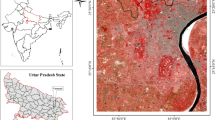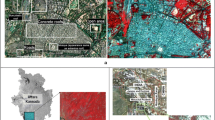Abstract
The image texture was extracted from Landsat TM data using rodogram, a geostatistical function, and then added to multispectral classification for lithological discrimination of an arid region, the Altun Mountains in northwest China. The variogram analysis of the image of the study area indicates that the image has two scales of textures: local and regional textures. Therefore, two different window sizes, 17×17 pixels and 61×61 pixels were chosen to extract textural information using rodogram. The results of image classification show that the classification based on spectral data and geostatistical textural information produced much higher overall accuracy than with the spectral classification alone. Moreover, large window size, at which textural information was extracted and then used for image classification, achieved more accurate result than small window size.
Similar content being viewed by others
References
An, P., Chung, C.F. and Renz, A.N., 1995, Digital lithology mapping from airborne geophysical and remote sensing data in the Melville Peninsula, northern Canadian using a neural network approach. Remote Sensing of Environment. 53, 76–84.
Berberoglu, S., Lloyd, C.D., Atkinson, P.M. and Curran, P.J., 2000, The integration of spectral and textural information using neural networks for land cover mapping in the Mediterranean. Computers & Geosciences, 26, 385–396.
Carr, J.R., 1996, Spectral and textural classification of single and multiple band digital images, Computers & Geosciences, 22, 849–865.
Carr, J.R. and Miranda, F.P., 1998, The semivariogram in comparison to the co-occurrence matrix for classification of image texture. IEEE Transactions on Geoscience and Remote Sensing, 36, 1945–1952.
Chica-Olmo, M., Arbarca-Hernandez, F., 2000, Computing geostatistical image texture for remotely sensed data classification. Computers & Geosciences, 26, 373–383.
Cressie, N. and Hawkins, D.M., 1980, Robust estimation of the variogram, 1. Journal of the International Association for Mathematical Geology, 12, 115–125.
Curran, P.J., 1988, The semivariogram in remote sensing: an introduction. Remote Sensing of Environment, 24, 493–507.
Deutsch, C.V. and Journel A.G., 1992, GSLIB: geostatistical soft-ware library and users guide. Oxford University Press, New York, p. 39–60.
Emran, A., Hakdaoui, M. and Chorowicz, J., 1996, Anomalies on geologic maps from multispectral and textural classification: the Bleida mining district (Morocco). Remote Sensing of Environment, 57, 13–21.
Glaseby, C.A., 1988, Normal distribution assumptions in discrimination. Proceedings of the International Geoscience and Remote Sensing Symposium (IGARSS 88), ESA SP-284, Paris: European Space Agency), p. 1789–1791.
Goovaerts, P., 1997, Geostatistics for Natural Resources Evaluation. New York: Oxford Univ. Press. 483 p.
Haralick, R.M., Shanmugam, K. and Dinstein, I., 1973, Texture feature for image classification. IEEE Transactions on Systems, Man, and Cybernetics, 3, 610–621.
Ince, F., 1987, Maximum likelihood classification, optimal or problematic? International Journal of Remote Sensing, 8, 1829–1838.
Lacaze, B., Rambal, S. and Winkel, T., 1994, Identifying spatial patterns of Mediterranean landscapes from geostatistical analysis of remotely-sensed data. International Journal of Remote Sensing, 15, 2437–2450.
Lam, N.S. and De Cola, L., 1993, Fractal measurement. In: Lam, N.S. and De Cola, L. (eds.), Fractals in geography. PTR Prentice-Hall, Inc., Englewood Cliffs, p. 23–55.
Lark, R.M., 1995, Contribution of principal components to discrimination of classes of land cover in multi-spectral imagery. International Journal of Remote Sensing, 16, 779–787.
Lark, R.M., 1996, Geostatistical description of texture on an aerial photograph for discriminating classes of land cover. International Journal of Remote Sensing, 17, 2115–2133.
Mather, P.M., 1999, Computer processing of remotely-sensed images. John Wiley & Sons, Chichester, p. 198–201.
Mather, P.M., Tso, B. and Koch, M., 1998, An evaluation of Landsat TM spectral data and SAR-derived textural information for lithological discrimination in the Red Sea Hills, Sudan. International Journal of Remote Sensing, 19, 587–604.
Mathron, G., 1971, The theory of regionalized variables and its applications. Les Cahiers du Centre de Morphologie Mathematique de Fontainebleau, Ecole des Mines de Paris, Fascicule 5, Fontainebleau, 211 p.
Miranda, F.P. and Carr, J.R., 1994, Application of the semivariogram textural classifier (STC) for vegetation discrimination using SIR-B data of the Guiana Shield, northwestern Brazil. Remote Sensing Reviews, 10, 155–168.
Miranda, F.P., Fonseca, L.E.N. and Carr, J.R., 1998, Semivariogram textural classification of JERS-1 (Fuyo-1) SAR data obtained over a flooded area of the Amazon rainforest. International Journal of Remote Sensing, 19, 549–556.
Ramstein, G. and Raffy, M., 1989, Analysis of the structure of radiometric remotely-sensed images. International Journal of Remote Sensing, 10, 1049–1073.
Ricchetti, E., 2000, Multispectral satellite image data and ancillary data integration for geological classification. Photogrammetric Engineering and Remote Sensing, 66, 429–435.
Schetselaar, E.M., Chung, C.F. and Kim, K.E., 2000, Integration of Landsat TM, Gamma-ray, magnetic, and filed data to discriminate lithological units in vegetated Granite-Gneiss Terrain. Remote Sensing of Environment, 71, 89–105.
Webster, R., 1985, Quantitative spatial analysis of soil in the field. Advances in Soil Science, 3, 1–70.
Woodcock, C.E. and Harward, V.J., 1992, Nested-hierarchical scene models and image segmentation. International Journal of Remote Sensing, 13, 3167–3187.
Woodcock, C.E., Strahler, A.H. and Jupp, D.L.B., 1988, The use of variograms in remote sensing: II. Real digital images. Remote Sensing of Environment, 25, 349–379.
Author information
Authors and Affiliations
Corresponding author
Rights and permissions
About this article
Cite this article
Li, P., Li, Z. & Moon, W.M. Lithological discrimination of Altun area in northwest China using Landsat TM data and geostatistical textural information. Geosci J 5, 293–300 (2001). https://doi.org/10.1007/BF02912700
Received:
Accepted:
Issue Date:
DOI: https://doi.org/10.1007/BF02912700




